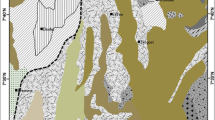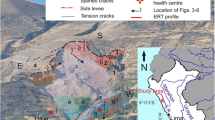Abstract
Soldha landslide zone is one of the prominent sites in district Kangra of Himachal Pradesh that witnessed large-scale mass movement in October 2013. This landslide destroyed six houses along with six livestock sheds causing the death of animals along with the destruction of 5.60 ha of agricultural land and 23 ha of forest cover that got uprooted. The study discusses the main geomorphic, geometrical, anthropogenic, and climatic parameters bordering the landslide zone which buried a complete village under the debris. This landslide zone resides at the thrust contact zone between the Middle Siwalik weathered sandstone-clay (the failed slope material) and the Upper Siwalik Boulder Conglomerates. The study of slope material shows its composition as well-graded sand and less than 30% gravels which reflected the weak and weathered condition of the slope material. The geometrical features of the landslide planiform and the rainfall analysis have helped to reveal the trigger factor of this progressive slope failure. The rainfall and the seismic data analysis have shown that the active tectonics due to the presence of thrust near the toe of the landslide have led to the progressive sub-surface disturbances and the monsoon rainfall has acted as a trigger factor for the slope mass movement. This study has addressed the geological as well as the climatic factors that have led to the mass movement and revealed the impact of the structural feature on a moderately inclined slope with settlements.


source: Google Earth)




source: after

source: NASA Earth)



Similar content being viewed by others
References
Ambraseys N, Bilham R (2000) A note on the Kangra M s= 78 earthquake of 4 April 1905. Curr Sci 79(1):45–50
Bainbridge R, Lim M, Dunning S, Winter MG, Diaz-Moreno A, Martin J, Torun H, Sparkes B, Khan MW, Jin N (2022) Detection and forecasting of shallow landslides: lessons from a natural laboratory. Geomat Nat Haz Risk 13(1):686–704
Bathrellos GD, Skilodimou HD, Zygouri V, Koukouvelas IK (2021) Landslide: a recurrent phenomenon? Landslide hazard assessment in mountainous areas of central Greece. Zeitschrift für Geomorphologie: 95–114.
Behling R, Roessner S, Segl K, Kleinschmit B, Kaufmann H (2014) Robust automated image co-registration of optical multi-sensor time series data: database generation for multi-temporal landslide detection. Remote Sens 3:2572–2600
Das S, Sarkar S, Kanungo DP (2022) GIS-based landslide susceptibility zonation mapping using the analytic hierarchy process (AHP) method in parts of Kalimpong Region of Darjeeling Himalaya. Environ Monit Assess 194(3):1–28
Dey S, Thiede RC, Schildgen TF, Wittmann H, Bookhagen B, Scherler D, Strecker MR (2016) Holocene internal shortening within the northwest Sub Himalaya: out of sequence faulting of the Jwalamukhi Thrust, India. Tectonics 35(11):2677–2697
Handwerger AL, Jones SY, Amatya P, Kerner HR, Kirschbaum DB, Huang MH (2021) Strategies for landslide detection using open-access synthetic aperture radar backscatter change in Google Earth Engine. Natural Hazards and Earth System Sciences Discussions. pp: 1–35.
IS - 2720 Part 4 (1985) (Reaffirmed 1995) Indian Standard Method of test for soils, grain size analysis, Bureau of Indian standards, New Delhi.
IS- 1498 (1970) (Reaffirmed 2007) Classification and identification of soils for general engineering purposes [CED 43: Soil andFoundation Engineering].
Jayangondaperumal R, Kumahara Y, Thakur VC, Kumar A, Srivastava P, Dubey S, Joevivek V, Dubey AK (2017) Great earthquake surface ruptures along backthrust of the Janauri anticline, NW Himalaya. J Asian Earth Sci 133:89–101
Kumar S, Mahajan AK (1990) Study of Intensities of 26th April 1986 Dbaramshala Earthquake (Himachal Pradesh) and Associated Tectonics. J Geol Soc India (Online archive from Vol 1 to Vol 78) 35(2):213-219
Kumar S, Mahajan AK (2001) Seismotectonics of the Kangra region, northwest Himalaya. Tectonophysics 331(4):359–371
Kumar R, Ghosh SK, Mazari RK, Sangode SJ (2003) Tectonic impact on the fluvial deposits of Plio-Pleistocene Himalayan foreland basin, India. Sediment Geol 158(3–4):209–234
Kumar S, Wesnousky SG, Rockwell TK, Ragona D, Thakur VC, Seitz GG (2001) Earthquake recurrence and rupture dynamics of Himalayan Frontal Thrust, India. Science 294(5550):2328–2331
Kumar S, Wesnousky SG, Rockwell TK, Briggs RW, Thakur VC, Jayangondaperumal R (2006) Paleoseismic evidence of great surface rupture earthquakes along the Indian Himalaya. J Geophys Res Solid Earth 111:B3
Kumar V, Jamir I, Gupta V, Bhasin RK (2021) Inferring potential landslide damming using slope stability, geomorphic constraints, and run-out analysis: a case study from the NW Himalaya. Earth Surf Dyn 9(2):351–377
Lombardo L, Cama M, Maerker M, Rotigliano E (2014) A test of transferability for landslides susceptibility models under extreme climatic events: application to the Messina 2009 disaster. Nat Hazards 74(3):1951–1989
Mukhopadhyay DK, Mishra P (1999) A balanced cross section across the Himalayan foreland belt, the Punjab and Himachal foothills: a reinterpretation of structural styles and evolution. Proceedings of the Indian Academy of Sciences-Earth and Planetary Sciences 108(3):189–205
Pourghasemi HR, Moradi HR, Aghda SF, Sezer EA, Jirandeh A, Pradhan B (2014) Assessment of fractal dimension and geometrical characteristics of the landslides identified in north of Tehran, Iran. Environ Earth Sci 71(1):3617–3626
Powers PM, Lillie RJ, Yeats RS (1998) Structure and shortening of the Kangra and Dehra Dun reentrants, sub-Himalaya, India. Geol Soc Am Bull 110(8):1010–1027
Rana K, Ozturk U, Malik N (2021) Landslide geometry reveals its trigger. Geophys Res Lett. 48(4): e2020GL090848
Sharma S, Mahajan AK (2018) Comparative evaluation of GIS-based landslide susceptibility mapping using statistical and heuristic approach for Dharamshala region of Kangra Valley, India. Geoenvironmental Disasters 5(1):4
Sharma S, Mahajan AK (2020) GIS-based sub-watershed prioritization through morphometric analysis in the outer Himalayan region of India. Appl Water Sci 10(7):1–11
Sharma R, Sharma UK, Mahajan AK (2015) Rainfall and anthropogenically accelerated mass movement in the Outer Himalaya, north of Dharamshala town, Kangra district, Himachal Pradesh: A cause of concern. J Geol Soc India 86(5):563–569
Sharma S, Mahajan AK (2019) A comparative assessment of information value, frequency ratio and analytical hierarchy process models for landslide susceptibility mapping of a Himalayan watershed, India. Bull. Eng. Geol. Environ. B ENG GEOL ENVIRON 78(4): 2431–2448.
Singh T, Awasthi AK (2019) Deformation in the Kangra Reentrant, Himachal Pradesh of NW-Sub Himalaya of India: a paradox. In Tectonics and Structural Geology: Indian Context: 381–396).
Singh T, Awasthi AK, Caputo R (2012) The sub‐Himalayan fold‐thrust belt in the 1905 Kangra earthquake zone: A critical taper model perspective for seismic hazard analysis. Tectonics 31(6).
Singh K, Kumar V (2018) Hazard assessment of landslide disaster using information value method and analytical hierarchy process in highly tectonic Chamba region in bosom of Himalaya. J Mt Sci 15(4):808–824
Skilodimou HD, Bathrellos GD, Chousianitis K, Youssef AM, Pradhan B (2019) Multi-hazard assessment modeling via multi-criteria analysis and GIS: a case study. Environ Earth Sci 78(2):1–21
Srivastava HN, Dube RK, Raj H (1987) Space and time variation in the seismicity patterns preceding two earthquakes in the Himachal Pradesh, India. Tectonophysics 138(1):69–77
Taylor F, Malamud B, Witt A, Guzzetti F (2018) Landslide shape, ellipticity and length-to-width ratios. Earth Surf Process Landf 43(15):3164–3189
Thakur VC (2004) Active tectonics of Himalayan frontal thrust and seismic hazard to Ganga Plain. Current Science, pp 1554–1560
Thakur VC (2013) Active tectonics of Himalayan frontal fault system. Int J Earth Sci 102(7):1791–1810
Thakur VC, Joshi M, Sahoo D, Suresh N, Jayangondapermal R, Singh A (2014) Partitioning of convergence in Northwest Sub-Himalaya: estimation of late Quaternary uplift and convergence rates across the Kangra reentrant, North India. Int J Earth Sci 103(4):1037–1056
Titti G, Borgatti L, Zou Q, Cui P, Pasuto A (2021) Landslide susceptibility in the Belt and Road Countries: continental step of a multi-scale approach. Environ Earth Sci 80(18):1–18
Varnes DCD (1996) Landslides: investigation and mitigation chapter 3-landslide types and processes. Transportation Research Board Special Report: 247.
Acknowledgements
The authors are thankful to their respective host institutes for providing all types of logistic and administrative support for this research work.
Author information
Authors and Affiliations
Contributions
Swati Sharma and A.K. Mahajan contributed to the study’s conception and design. Material preparation, data collection, and analysis were performed by A.K. Mahajan, Swati Sharma, Desh Deepak Pandey, Harsh Sharma, Sunanda Patial, and Sushma Negi. The manuscript draft was written by Swati Sharma and all authors commented on previous versions of the manuscript. All authors read and approved the final manuscript.
Corresponding author
Ethics declarations
Conflict of interest
The authors declare that they have no competing interests.
Additional information
Responsible Editor: Zeynal Abiddin Erguler
Rights and permissions
About this article
Cite this article
Mahajan, A.K., Sharma, S., Patial, S. et al. A brief address of the causal factors, mechanisms, and the effects of a major landslide in Kangra valley, North-Western Himalaya, India. Arab J Geosci 15, 925 (2022). https://doi.org/10.1007/s12517-022-10163-w
Received:
Accepted:
Published:
DOI: https://doi.org/10.1007/s12517-022-10163-w




